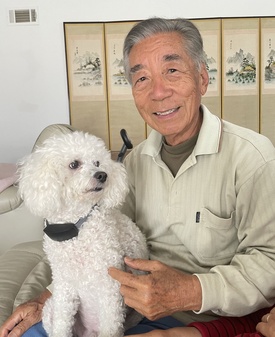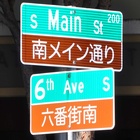Kensuke Ozaki (83), originally from Kochi Prefecture and currently living in California, has been working in the US for many years in the trade industry and other fields. He has recently self-published an English novel, "The Destiny of a Castaway JOHN MANJIRO," which follows the life of local hero John Manjiro. We interviewed Ozaki, who has tried various business ventures in Central America and the US, about his motivation for publishing the novel, the reactions he received, and his plans to adapt it into a film.
* * * * *
Q. Why did you decide to write about John Manjiro?
Ozaki: Manjiro was a proud figure in my hometown of Kochi Prefecture, and he was my goal when I wanted to make a leap abroad. At the age of 27, I took the plunge and quit my job and traveled to Panama, where I have since worked in trade, mainly in the Caribbean, and have managed to live a fulfilling life abroad.
Q. Why did you decide to publish it in English?
Ozaki: There are many research books on Manjiro in Japan. A few books written by American enthusiasts have been published overseas, but I felt that they did not fully understand the situation in Japan at the time, so I wrote this book in English from a Japanese perspective, and wanted to share it not only with America but with the whole world. I published it at my own expense, but it will soon be published on Kindle along with three other books I have written.
Q. The story is told in the first person, with Manjiro narrating it. Why was that?
Ozaki: At first, I tried writing it in the form of a movie script, but I wasn't sure if it would work, so I decided to write it as a first-person novel. I thought that this way it would be read by the general public.
Q. Please tell us about the process of completing this work. How long did it take from conception to completion? What was the most difficult part, and what was the most enjoyable part of writing it?
Ozaki: I went back to Kochi every year, and 10 years ago I met Mr. Atsuya Nagakuni, a well-known Manjiro researcher, through my younger brother Saburo, who is a member of the International John Manjiro Club. I was given several books published by Mr. Nagakuni, and became interested in Manjiro after listening to his stories. Mr. Nagakuni translated "(John Manjiro) Hyosonkiryaku 1 " into English and published it together with Junji Kitadai.
The idea for this film came about 10 years ago, when I simply thought that if I made a movie about Manjiro, the whole world would know about him. First, I bought a book published in Japan and used it as reference. I'm not a researcher, so I used a book with an interesting plot.
Manjiro himself left behind a lot of documents, which I pieced together, but there was a gap in his student years in Fairhaven, so I imagined that he wasn't just studying during that time, but that he had a girlfriend that he wanted to marry, and I put it in the form of a novel.
Q. What attracted you to John Manjiro’s life and way of living?
Ozaki: Manjiro's way of life was to follow the instructions of heaven and do his best in each situation, but he himself was not aware that these were instructions from heaven, and we in later generations have inferred these instructions. We are the same; when we remember the past, we feel a sense of destiny (the instructions of heaven), so we can sympathize with Manjiro's way of life.
Q. Kochi Prefecture is a prefecture that is open to the sea. Is there any relationship between the character of Kochi people and the way of life of John Manjiro? What about you, Mr. Ozaki?
Ozaki: There are two types of temperament in Kochi Prefecture. There is the temperament of people living near the sea (ocean type) and the temperament of people living in the mountains (mountain type). The ocean type includes Manjiro, Sakamoto Ryoma, Iwasaki Yataro, Goto Shojiro, Yoshida Shigeru, etc. The mountain type includes Makino Tomitaro, Terada Torahiko, Nakae Chomin, Kotoku Shusui (scholar type), etc. I am of the ocean type, and it seems that going abroad was the right decision for me.
Q. How are you spreading this work in the U.S.? Where are you distributing or selling it?
Ozaki: We plan to donate them to Japanese consulates, Japanese language schools, libraries, and other institutions related to Japan.
Q. What kind of reactions and feedback have you received from American readers (those who are learning about John Manjiro for the first time)?
Ozaki: I distributed this book at a meeting of neighbors who have no connection to Japan. They said that they learned for the first time that America was once a leading whaling country and exported whale oil to Europe, and that it was their relationship with Japan. They also said that the story was so interesting that they read it all in one go. It's written in junior high school level English, so it's probably easy to read.
Q. I heard that you are planning to make a movie based on this novel. Can you tell me about that?
Ozaki: My initial idea was to make it into a movie so that it could be seen all over the world, so my goal is to make it into a movie. Of course, I am thinking of contacting Hollywood producers to see if there are any investors who have read the book that I plan to release on Amazon Kindle, but since there are twice as many Japanese actors as Americans, I think there is a possibility that I can sell the idea to Japanese film companies and investors, and if we can make a joint venture with an American film company, we can make it into a movie.
Q. (Though not directly related to John Manjiro) Having lived in America for many years, what are your impressions of Japanese and Japanese-Americans in America?
Ozaki: For example, my daughter (second generation) married an American, and her children only use English, so they don't seem to have much interest in Japan. There are few English reading books about Japan for elementary and junior high school students, and I intended to write my book in an easy-to-understand way about the history of Japan before and after the Meiji Restoration. I think it is important to teach the younger generation about Japan.
Q. Please tell us about your life abroad and your work . Also, please tell us what you are currently working on and what you want to work on in the future.
Ozaki: When I was 28, I moved to Panama with the hope of going independent overseas using the Spanish I had studied at Osaka University of Foreign Studies. After that, I worked in trading based in the Caribbean (Puerto Rico, Dominican Republic) while obtaining permanent residency in the USA and opening a Japanese restaurant in St. Petersburg, Florida (53 years ago it was only the second Japanese restaurant in Florida). I also found eels on the St. Johns River (Florida), froze them and exported them to Japan, and had ingredients for grilled offal made in Colorado/Kansas and exported them to Japan. I tried a lot of things, but it was too early and none of them worked out.
In the end, the steel products that the Japanese trading company handled were sold to Florida through a foreign trading company, and the company continued trading in the Caribbean, and survived.
In 2019, I was planning to retire from Miami, where I had lived for over 40 years, to California, but I am also thinking about turning the four screenplays I have written in English into novels, and at the same time, I am trying to start a big business I have always wanted to do (selling petroleum products, natural gas, and iron ore to government-related companies in China and India). However, I cannot do this alone, so I am currently looking for a partner.
My wife and daughter tell me to think about my age, but I was prepared to die alone when I left Japan for Panama, and that is still the same now. My body is worn out with age, but my feelings are the same as they were before.
Notes:
1. This is a historical document recorded by Koryu Kawada, who interviewed John Manjiro about the events that occurred during the ten years from his shipwreck to his return home, complete with detailed drawings.
2. Keiko Fukuda, " Ozaki Kensuke: A Trader in Central America and the Caribbean " (Discover Nikkei, October 27th and 28th , 2015) - Featured in two parts.
* "The Destiny of a Castaway JOHN MANJIRO": 190 pages. As a historical document, it is chock full of photographs, illustrations, and maps. For inquiries, please contact production collaborator Soichiro Umehara ( ume.12117@gmail.com ).
© 2022 Ryusuke Kawai








